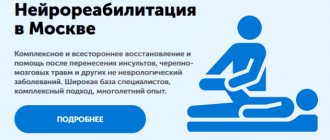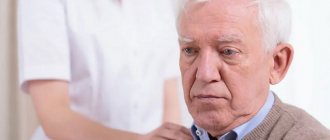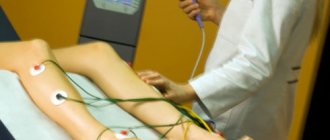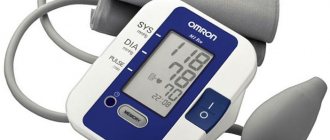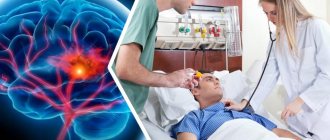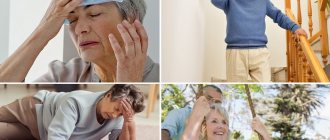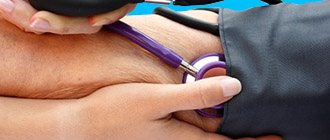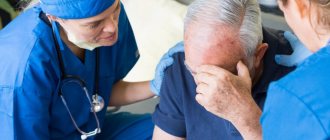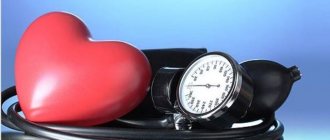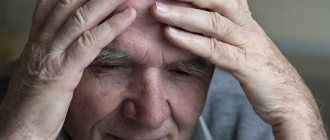March 15, 2021
When the acute stage after a stroke ends, the patient is discharged from the hospital, then a new period begins - the person’s recovery after a stroke at home.
In this article we tell you how to properly care for victims, restore their movement and cognitive functions, and provide psychological support so that rehabilitation after a stroke at home is systematic and gives the desired effect.
Teaching basic skills for the recovery of older people after a stroke
Elderly people who have suffered a stroke and their relatives need to immediately understand that rehabilitation will not be easy. The recovery of patients after a stroke can be compared to the development of a child after birth: first he crawls, then sits, then stands on his legs and only then begins to walk. Nature has its own laws, and it is impossible to “skip” any stage of development. The same can be said about activities for the recovery of older people after a stroke: stopping or even taking a break from exercise means returning to the previous position.
The goal of recovery measures after a stroke is to reacquire self-care skills and everyday behavior.
The patient needs to perform a set of simple exercises to restore self-care skills. He learns to turn on the tap, use a toothbrush, put on things, fasten buttons - that is, perform actions that he could do before the stroke, like any healthy person. But now it seems impossible, because the ability to move has been lost. Therefore, any action is first disassembled into its components and worked out step by step. This is how the rehabilitation process begins.
In order to open a tap, you must first reach out to it. This action can be practiced even when an elderly person is in a supine position after a stroke. Perhaps he will perform this action more than once or twice, making mistakes and starting over, but in the end he will succeed. Other movements are practiced in the same way. By repeating the same actions every day, the patient brings them to automaticity, while neural bridges are formed in his brain, restoring connections between the action and a certain area of the brain responsible for its implementation.
This is difficult and painstaking work, but it is what helps older people who have suffered a stroke get on the path to recovery and regain lost skills.
We recommend
“Tumors in the elderly: causes, diagnosis and treatment” Read more
What to prepare for welcoming a patient from the hospital?
The conditions for home treatment of a patient with a stroke should first of all provide for his safety and ease of mastering movements.
The bathroom, toilet, and bedside area must have grab bars or other devices that allow the patient to sit down and stand up without assistance.
- You should remove unnecessary things, boxes, carpets, wires from home appliances from the paths of movement. They increase the risk of falling.
- Some patients lose their sense of temperature and can get burned by too hot water. This will require installing thermometers in the bathroom.
- At first, it is better to use a tray or a small portable table for the patient’s food; it will be difficult to be in a common kitchen or dining room.
The purchase of a wheelchair can be postponed for six months, when the prospects for rehabilitation measures become clear. During this period, the patient may begin to walk independently.
If watching television programs is of great interest to the victim, then he will need a remote switch.
What contributes to the restoration of motor functions in older people after a stroke?
First of all, efforts to rehabilitate stroke patients are aimed at restoring motor functions. This is due to the fact that in 95% of cases, victims experience varying degrees of paralysis. When a person begins to move, blood circulation improves, the threat of bedsores disappears, the patient can simply take care of himself and perform some simple actions. After this, the rest of the lost abilities are restored at an accelerated pace.
General recommendations for physical therapy for the recovery of older people after a stroke:
- The choice and schedule of exercises must be agreed with a specialist (physical therapy doctor or rehabilitation specialist).
- The intensity of the loads needs to be increased gradually, taking into account the actual capabilities of older people.
- As the load increases, it is necessary to complicate the technique of motor exercises: simple flexion-extension should be replaced by targeted subtle movements to restore the functions of the hands using auxiliary objects: rosaries, expanders, gymnastic sticks, exercise machines, circular elastic bands, musical instruments.
- If older people feel pain when moving, the load should be reduced.
- Before starting the exercises, it is necessary to prepare the muscles, stretch them with massage, rubbing or warming.
- The main goal of physical therapy is to relax muscles that, after a stroke, are in a state of hypertonicity (severe tension).
- No need to get overtired. The optimal schedule for performing gymnastic exercises is twice a day for an hour.
- During physical therapy classes, the breathing of older people should be monitored - check that its rhythm is smooth, inhalation and exhalation accompany a certain part of the exercise. For example, flexion should occur while inhaling, extension should occur while exhaling.
- It is advisable to have a loved one with older people when they perform stroke recovery exercises in a sitting or standing position. Relatives can support the patient or monitor the process; their presence will help avoid injury if the patient suddenly falls.
- Rehabilitation necessarily involves the prevention of contracture. The more time the limbs of older people are in the same position (bent at the knee or elbow), the stronger the muscles are fixed in the wrong position. Therefore, you need to place a soft cushion between the bent parts (in the elbow or popliteal fossa), which can be rolled fabric. To prevent contracture, you can also use a bandage or plaster to fix the straightened limb on a hard surface (board).
Each exercise can be repeated from 2-3 to 10-15 times. It all depends on the physical capabilities of sick elderly people. Once simple exercises have been mastered, it is important not to stop, but to move on, increasing complexity.
We recommend
“Health of the elderly: old age is not a problem” Read more
For lower limbs
Exercises for the lower extremities begin to be performed as soon as the patient regains consciousness. At the initial stage, the instructor helps to bend and straighten the lower limbs; over time, the patient will be able to imitate walking in a prone position, then get out of bed, learn to maintain balance, and walk without support. Exercises for patients in the supine position:
- The patient is in a supine position, the leg is straightened. The instructor turns the leg with the foot inward, then outward.
- The patient is in a supine position, the leg is bent at the knee. Holding one hand under the knee, the instructor performs circular movements with the limb, holding and pressing with the other hand in the hip joint area.
- The patient is in a supine position, the affected leg is bent at the knee. The instructor fixes the leg at a right angle, holding it with the other hand under the knee, bends and straightens the lower limb.
- The patient is in the same position on his back, with the leg fixed at a right angle. The instructor, holding the patient's leg under the knee, moves it away from the body and returns it back.
These exercises are performed by the patient after he is allowed to sit:
- In a half-sitting position, holding the edges of the bed with both hands, stretch both legs forward as evenly as possible, bend over, throwing your head back. While stretching your limbs, take a deep breath, return to your previous position and exhale.
- Remain in the same body position, keep your breathing calm and deep, slowly lift your right leg up and lower it back, then your left leg.
- In a half-sitting position, bend your leg, pull your bent leg at the knee as close to your chest as possible (you can help with your hands), and tilt your head forward during the exercise. Bending the leg, inhale, straightening the limb, exhale, return to the previous position.
Restoring speech in older people after a stroke
The most intensive restoration of speech functions in elderly people is observed in the first 6 months after a stroke; in the case of extensive lesions or late treatment, it can last 2–3 years.
Depending on which areas of the brain were affected by the stroke, patients experience a motor or sensory form of speech impairment (aphasia). With the motor type, the patient:
- perceives speech by ear;
- understands what is being said to him;
- responds to requests;
- cannot formulate thoughts and pronounce phrases;
- does not want to read and write, as these processes are difficult for him.
With sensory aphasia, the patient does not perceive the words of others, he himself speaks incoherently, without controlling the speech flow. Such a patient can read, but will not understand the meaning of sentences; writing skills are completely lost. The speech of older people after a stroke is not meaningful enough and is accompanied by gestures. Patients try to explain what they want to say to others, but they do not understand them, and as a result they become irritated and offended.
In this case, you need to understand that even long exercises to restore speech after a stroke (lasting several months or even years) may not give a positive effect. In 30–35% of cases, speech functions return spontaneously and not gradually.
In order for older people to start speaking after a stroke, they need to constantly hear sounds, words, and expanded speech.
During rehabilitation, it is necessary to follow the principle of the sequence of stages. You can start classes by practicing the pronunciation of individual sounds, then you can move on to syllables, simple and complex words, and then to small poems and sentences. When working with older people after a stroke, you can help them a little - pronounce the initial part of the word, and they will finish the ending themselves.
Also, to restore speech, older people are recommended to listen to music and sing. Often, patients after a stroke cannot speak normally, but retain the ability to sing. In this case, you should definitely try to sing - this will activate speech restoration.
Exercises to rehabilitate facial muscles are best done in front of a mirror. Such classes are especially indicated in cases where an elderly person has a distorted face after a stroke. To do this you need to do the following:
- bare teeth;
- curl and protrude your lips into a “tube”;
- opening your mouth, push your tongue forward as much as possible;
- alternately bite your upper and lower lips;
- lick your lips with your tongue in a circle, first in one direction, then in the other direction;
- pull the corners of your mouth up, as if smiling.
During speech rehabilitation classes with older people, you can use the following:
- showing the patient cards on which letters, syllables and words are written, asking him to compose a sentence from them and read it;
- encourage the patient to communicate: ask questions, sing together, recite poetry;
- listen to your favorite audiobooks with the patient and retell their contents;
- look at the pictures and then ask them to describe them.
If relatives conduct classes with a patient who has suffered a stroke at home, it is important to be kind to even the slightest attempts by the patient to pronounce words, to encourage him, and not to correct mistakes. To help older people overcome their speech impediment, you need to be persistent and constantly communicate with them.
We recommend
“Senile dementia: causes, symptoms, treatment” Read more
What does the success of rehabilitation depend on?
The study of the rehabilitation capabilities of a person and his brain made it possible to identify the main factors of success. These include:
- localization and size of the lesion;
- the age and state of the patient’s body’s defenses before the stroke;
- his level of education (people with higher education recover faster);
- profession and social living conditions (a person accustomed to constant creativity and learning achieves success faster);
- the desire of the patient himself (level of motivation);
- support and understanding of relatives;
- therapeutic measures after discharge from the hospital.
Only in last place are the professional skills of medical workers and the provision of hospitals with special equipment.
When organizing home care for a person with an ischemic stroke, imagine yourself in his shoes. He has to relearn childhood skills, realizing his weakness and dependence on outsiders. All patients have a chance for rehabilitation. The ability to survive an ischemic stroke and faith in one’s own abilities largely depend on what kind of support they receive from relatives.
A set of measures to restore memory and intelligence in older people after a stroke
It is better to begin rehabilitation of mental abilities while patients are in the hospital, after the general condition after the stroke has stabilized. But the brain of older people should not be subjected to excessive overload.
Restoration of memory functions is accompanied by preliminary drug therapy aimed at maintaining stroke-damaged nerve cells. Elderly people are administered the appropriate drugs (Actovegin, Thiocetam, Piracetam, Cavinton, Cortexin) intravenously, or they take them in tablet form. The therapeutic effect of the use of drugs appears slowly, over 3–6 months. The course of medication is repeated after 2–3 months.
When restoring memory, the following rehabilitation actions are carried out:
- Train your memorization ability: listen and repeat numbers, words, short poems. First, you need to achieve short-term memorization - when the patient can repeat information immediately after listening to it. Then the memorization period should be increased - for example, the patient will independently pronounce the numbers when asked to count.
- Look at photographs and videos, while remembering and pronouncing the names of all the objects depicted.
- Play boardgames.
We recommend
“Diabetes mellitus in older people: features of diagnosis and treatment” Read more
Classification of walking disorders
In the early 1990s. Nutt et al. proposed to classify walking disorders as being at the lower, intermediate, or higher sensorimotor level [27]. According to this scheme, the lowest level of walking disorders is caused by pathology of peripheral formations that provide movement, such as joints, muscles, peripheral nerves, the organ of vision or the labyrinth. Disturbances at the lower level are usually well compensated if the central nervous system is not involved. Intermediate gait disorders are associated with dysfunction of afferent and/or efferent (pyramidal or extrapyramidal) pathways in the central nervous system (eg, hemiparesis after stroke, myelopathy in cervical spondylosis, muscle rigidity in parkinsonism, or ataxia in cerebellar lesions). Higher-level walking pathology is based on violations of higher control of sensorimotor functions, which ensure adequate reactions to external circumstances (for example, lighting or surface quality) and the implementation of the patient’s intentions. Such disorders can occur due to the effects of chemical compounds (including drugs and alcohol) or damage to the frontal lobes, as well as mental disorders. Higher level gait disorders are often difficult to differentiate due to the non-specificity of their manifestations [31]. Higher level gait disorders are associated with depressive symptoms, signs of frontal disinhibition (axial signs) and executive dysfunction [1]. A prospective study showed that higher level gait disorders are often progressive in nature and are accompanied by a rapid deterioration in the patient’s functional status [14].
However, despite its wide popularity, this classification has limited practical value, so we prefer to define the subtype of gait disorders based on clinical manifestations as recommended by Snijders et al. [33]. The most common types of walking disorders are associated with sensory (polyneuropathy), extrapyramidal (parkinsonism), ataxic (cerebellar degenerations) and psychogenic (anxiety-phobic) disorders [17]. The clinical approach to classifying gait disorders involves a number of basic steps. At the first stage, based on the walking pattern, the results of special tests and accompanying symptoms, a clinical syndrome is diagnosed (for example, akinetic-rigid disorder, which may be based on parkinsonism). The most likely clinical diagnosis (eg, multiple system atrophy) is then determined based on the results of additional studies (eg, magnetic resonance imaging (MRI) or electroneuromyography), response to specific treatment (eg, levodopa), and disease course. Unfortunately, the diagnosis can often be confirmed only on the basis of pathomorphological data [17].
The main features of gait disorder syndromes associated with muscle paresis, spasticity or ataxia are presented in Table. 1 [2, 17, 21, 31, 33].
Home care rules for the rapid recovery of older people after a stroke
In the first days after a stroke, you should contact a specialist in physical therapy so that he can teach relatives how to carry out the necessary exercises with an elderly patient at home. In this case, the rehabilitation process will go faster and more efficiently.
Practice proves that the best results in the recovery of older people after a stroke are obtained by a combination of active treatment with physical activity started as early as possible. If a person survives, it means that he has opportunities for rehabilitation.
WHO has published a program that outlines the principles and steps for returning affected people after a stroke to an active life and restoring their life-saving skills. The document also describes all the necessary exercises that can be done at home.
Recovery of older people after a stroke is possible only with the help of loved ones or special personnel. It is impossible to go through the rehabilitation process on your own; it is a very difficult task.
Elderly people during rehabilitation after a stroke need not only moral support, but also practical assistance. Restoring the ability to move occurs as follows: a relative takes the patient’s immobile limb and begins to perform simple movements with it - stretching, straightening or bending, turning, simulating grasping, etc. Doing such movements at home is not difficult. It takes time for the brain to remember how certain muscles work. Time will pass, and the patient will begin to slowly move the limb, before this he will have to be frequently corrected and asked to repeat the exercises. The restoration of active movements that the patient can perform independently will mean the end of rehabilitation measures.
Gross motor skills return most quickly. The ability to make precise movements with the hand and fine facial expressions after a stroke will return at the very end of the last recovery period.
The exercises must include verbal and visual components; this is necessary for proper treatment. During classes, you need to describe and show sick elderly people everything that happens. This promotes the formation of new neural connections.
The exercises are performed in front of a large mirror so that the person can see himself in full height. Some time should pass between saying what will happen now and the actual action. The assistant says: “Now we will raise our hand,” waits for some time until the elderly patient understands the meaning of what was said, and only then raises his hand. The patient sees all these actions in the mirror. Such activities also help restore memory.
Treatment at home shows very good results, because so much love and care is invested in it from loved ones. We must remember that perseverance will be the main assistant.
Of course, when conducting recovery classes, you always need to realistically assess the capabilities of an elderly person who has suffered a stroke. In this case, a doctor will always help, who will tell you how to act. It is important for relatives to follow one more rule: do not exclude an elderly patient from the life of the family, do not let him become obsessed with the disease.
Relatives are also advised not to take manifestations of anger and aggression on the part of the patient to heart, and to learn not to react to such emotional outbursts. In this case, you need to try to put yourself in the place of a person whose life seems to have hit a wall with acceleration. The consequences of a stroke are manifested, among other things, in emotional disorders, and this is facilitated not only by severe organic brain damage, but also by the new social status of an elderly person: he falls out of his usual environment, is deprived of work, pleasure, and communication. Not everyone can survive this.
The behavior of relatives and their reaction to what is happening determines how the atmosphere in the family will develop in the future and how the recovery of the elderly patient will proceed. If you don’t let negativity sprout in your soul, then you can overcome any difficulties. If you follow the lead of scandals and reproaches, the little that could still be saved will be destroyed.
We recommend
“Low blood pressure in older people: causes, symptoms and treatment” Read more
Introduction
To ensure normal walking function, the interaction of almost all levels of the nervous system is necessary [24, 26].
A key role in this process is played by the elements of locomotion (the initiation and maintenance of rhythmic movements of the limbs), balance and higher mental functions, including the ability to adapt to external conditions. The existence of autonomous spinal gait pattern generators was discovered about 100 years ago when Brown demonstrated the preservation of locomotor movements in a cat after complete transection of the brainstem. The presence of a similar generator in humans is evidenced by the coordinated movements of all four limbs when walking. However, in humans, supraspinal control of gait appears to play a major role, including the influence of the frontal cortex, basal ganglia, subthalamic, cerebellar and mesencephalic locomotor areas, as well as the pontomedullary reticular formation [17]. Damage to many organs and systems of the body can lead to various walking disorders. Older adults often have complex gait disorders caused by multiple factors, so describing all the gait features of a given patient can be difficult [33]. The results of a population-based study indicate that the prevalence of walking disorders among people over the age of 70 years reaches 35% [44]. If 85% of people under the age of 60 have a normal gait, then at 85 years and older this figure drops to 18% [36]. Walking disorders are a risk factor for injuries, physical inactivity, deterioration of physical condition, and decreased quality and life expectancy [2, 35]. Falls appear to be the most common adverse event associated with gait disorders. Among home-dwelling people over the age of 65 years, about 30% fall at least once per year, and in long-term care facilities this figure exceeds 50% [17]. The injuries a patient can suffer from an unexpected fall range from minor abrasions to severe fractures and traumatic brain injuries. Another important consequence of walking disorders is often limited mobility, which, in turn, leads to an increased need for assistance [33]. Limited mobility is often aggravated by the fear of falling, which has a significant impact on the patient’s quality of life [17, 18]. Due to inactivity, patients with walking impairments are at increased risk of cardiovascular disease and dementia [23]. On the other hand, walking disorders may be one of the early clinical manifestations of cerebrovascular or neurodegenerative diseases [33]. Finally, gait disorders are associated with an increased risk of death due to falls, poor physical performance, and underlying medical conditions [44, 46]. This review presents a modern clinical approach to the diagnosis of walking disorders, characterizes the main subtypes of walking disorders, and examines the interdisciplinary treatment of walking disorders after stroke and other neurological diseases. This information, which is a synthesis of literature data and our own experience of neurorehabilitation of patients in the department of stroke, neurorehabilitation and long-term disorders of consciousness of the Oberig clinic, can be useful for physical rehabilitation specialists and doctors of various specialties providing assistance to patients with movement disorders.
A set of active exercises for legs
For the legs, exercises can also be started with a period of strict bed rest and continued while sitting. The number of repetitions should not tire the patient and increase gradually to 20.
- The toes actively perform flexion and extension.
- Pull your socks towards you, then move them to the opposite extreme position (it is recommended to mentally imagine the pressure on the pedals).
- Slow knee flexion, extension.
- Abduction to the side due to the work of the hip joint.
A set of active movements for the hands
You can make independent movements with your hands up to 20 times in one approach:
- clench and unclench your fingers into a fist;
- circles in both directions in the wrist joint (it is recommended to keep your fist clenched);
- flexion and extension at the elbows;
- from a position along the body, slowly rise and fall, while loading the shoulder joints;
- swing to the sides.
Exercises with dumbbells use flexor muscles and hold by clenching the hand into a fist.
Changing body position in bed
After a stroke, the patient spends most of the time in bed. In this condition, gymnastics is already necessary for rehabilitation after a stroke. You need to lie on both the healthy side of the body and the affected one, correctly distributing the weight of the body.
Man lies on his back
- straighten healthy and affected limbs;
- Place a pillow under the affected arm.
Man lies on the paralyzed side of the body
- put a pillow under your back, the shoulder blade is outside the pillow;
- straighten the affected arm with your palm facing up;
- straighten the affected leg and bend the knee slightly;
- Bend the healthy leg and place it on a pillow in front of the sore leg.
Man lies on the healthy side of the body
- put a pillow under your back;
- Straighten the affected arm and place it on top of the pillow, palm down;
- Straighten your healthy leg and bend your knee slightly;
- bend the affected leg and place it on a pillow in front of the healthy leg.
The body position of a sick person should be changed as often as possible. On average - every 40 minutes.
Neurogenic intermittent claudication
If after a short walk the patient reports that his legs are tired, neurogenic intermittent claudication due to lumbar spinal stenosis can be suspected, which should be differentiated from vascular intermittent claudication and poor physical condition (detraining) [31]. A characteristic symptom of spinal stenosis is the relief that the patient experiences when bending forward (for example, it is easier for him to ride a bicycle and it is much easier to walk using a shopping cart). In our practice, in such cases, as soon as the patient complains of leg fatigue, we suggest that he continue walking with a walker. If walking with a walker is much easier, the patient is very likely to have spinal stenosis and an MRI of the lumbosacral region is indicated.
Walking and mental functions
For a long time, walking was considered an automatic motor act that is carried out without the involvement of higher mental functions. However, about 20 years ago, a relationship between walking and cognitive performance was demonstrated [33]. Normal walking requires route planning and constant interaction with the environment, allowing appropriate adjustments to be made to the original plan. Misjudging the nature of the surface or obstacles, choosing a dangerous path, or overestimating one's own physical capabilities can cause a fall. Thus, the safety and efficiency of walking depend not only on the state of the body's sensory and motor systems, but also on cognitive functions, such as executive functions, spatial orientation, visuospatial perception and attention, as well as on the emotional state of the person. In the mid-1990s. Lundin-Olsson et al. first reported that inability to carry on a conversation while walking is associated with an increased risk of falls [22]. Since then, performing another task while walking (e.g., counting from 20 to 1) has been considered a classic way of identifying the relationship between walking and cognitive performance. In some neurological diseases accompanied by obvious movement disorders (for example, stroke or Parkinson's disease), the severity of all neurological disorders, including gait impairment, may increase when performing a parallel task [48].
Research suggests that executive functions are particularly important for safe walking. Executive dysfunction may be a major cause of falls in older adults [34]. Walking disorders, especially falls, can cause maladaptation, depression, anxiety and fear [33]. Inability to carry on a conversation while walking indicates an association between walking and cognitive impairment and can also be used as a diagnostic test [22, 43]. Deterioration or inability to walk while simultaneously performing another task is characteristic of neurodegenerative and vascular lesions of the cerebral cortex and subcortex, as well as parkinsonism [33].
What other movements need to be developed?
Physical education after a stroke, in addition to the limbs, requires the development of facial muscles, especially the eyes. To prevent drooping of the eyelid, the following exercises are recommended 5-7 times:
- eye movements up and down and to the sides;
- describe a circle with your eyes in one direction, then in the other;
- blink and squeeze for a few seconds.
To strengthen your neck muscles you need to:
- make slow turns of the head to the sides;
- rest your head on the pillow, then relax.
After a stroke, a person loses the ability to make small movements with his fingers. And this is very necessary in restoring self-service. To develop hand motor skills it is recommended:
- Place small items (nuts, buttons, spools of thread, pencils) in a large bowl;
- the patient should transfer them with the affected hand from one bowl to another.
In sanatoriums, games of mosaic, lotto, and collecting pyramids are used.
